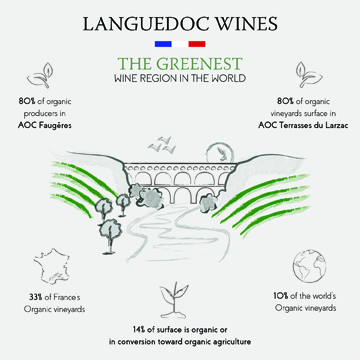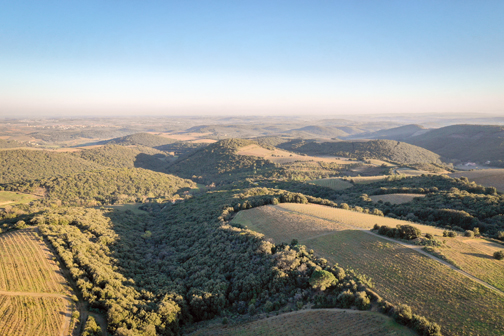Languedoc: Home of Eco-Friendly Wines
by
Sarah Moreau
Many an avid wine drinker would be surprised to find out that more than ten percent of the world’s organic vines are concentrated in one lesser-known French wine region: Languedoc.
 Located in the South of France where the Mediterranean sun shines year-long, Languedoc is the California of France. Its wines are, as a matter of fact, growing on Americans – imports stateside have known sustained growth.
Located in the South of France where the Mediterranean sun shines year-long, Languedoc is the California of France. Its wines are, as a matter of fact, growing on Americans – imports stateside have known sustained growth.
In Languedoc, sustainability is a code of honor. The region represents 33% of France’s organic vineyards, growing over 100 different grape varieties including an impressive number of native grapes.
Principles of organic farming, including the absence of artificial chemicals and GMO products in winemaking, are well-respected. This culture dates to the 1970s, when Languedoc producers in the Corbières area pioneered organic vine development.
Languedoc’s Foray into Rosé Wines
Languedoc’s production of rosé wine represents 30% of France’s rosé market and 8% of the world’s production.
With many organic or natural, Languedoc rosés span the pink color palette from unripe peach to deep coral. Blessed with elements of sunshine, ocean breezes and soil diversity, still and sparkling rosés from Languedoc are worth discovering.
While most Languedoc rosés are bright pink in color, some also present a more vigorous pink hue. On the nose, they offer intense floral and red fruit notes. The palate is round, full-bodied, supple and sweet.

The Birthplace of Sparkling Wine
The Languedoc wine region has three sparkling-producing appellations: AOC Crémant de Limoux, AOC Limoux Blanquette de Limoux and AOX Limoux Méthode ancestrale. It also uses three grape varietals: Mauzac, a local grape used as a main component, Chardonnay and Chenin.
Limoux is the true birthplace of bottle-fermented sparkling wine. After bottling and corking wine at the Saint-Hilaire Abbey, Benedictine monks in the 1500s noticed bubbles forming. The first ever sparkling wine was thus created by inadvertence through fermentation under pressure in a bottle.
The Limoux method is at the origin of the ancestral method of sparkling winemaking, and the ancestor of traditional method sparkling wines as we know them today.
Wine Pairing Suggestions
With summer approaching, there is no better way to enjoy organic Languedoc wines than with delicious, fresh foods. Here are a few of my favorite pairings:
Rosé Languedoc Wines
• Fougasse, the French cousin of Italian focaccia, pairs very well with rosé wine from Languedoc with its delicious bites of cheese, olives and bacon.
White Languedoc Wines
• Fresh oysters go beautifully with AOC Picpoul de Pinet.
• Local Roquefort cheese harmonize well with sweet Languedoc white wine such as Muscat, offering a savory and sweet balance.
• French goat cheese.
Red Languedoc Wines
• Cassoulet, the region’s hearty bean stew, ideally pairs with vibrant full-bodied reds.
• Any meat cooked in Provence herbs or game in sauce.
• Salads from the Nicoise to gourmet iterations.
Article written May 2021.
About the Author
An award-winning wine PR expert, Sarah Moreau helps the world’s top vineyards achieve visibility and awareness in the US. She writes articles and blog entries for Wine Trail Traveler with a focus on French wines. A WSET graduate, Sarah also speaks at various industry conferences across the country.
